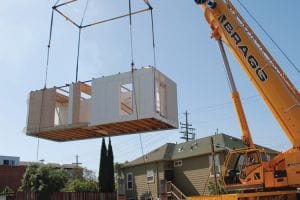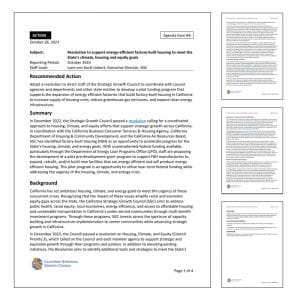Breaking Down the “Modular Building Code”
It seems as if the topic of modular construction has become quite popular these days. But with this newfound popularity comes a great deal of confusion and even misinformation. MBI often gets calls from people asking, “what is the modular building code?” So, let’s answer that question first:
There is no modular building code.
Regulating Modular Construction
While there is no modular code, our industry does have is a series of administrative rules and regulations, and in some cases guidelines and standards in place. But in terms of the building itself, our industry constructs to the same applicable building codes as our site-built peers.
In the United States, that is typically a state-adopted version of the International Building Code (IBC). The IBC is updated every three years, with the latest version known as the “2018 IBC”. Each state has its own code adoption cycle and polices for amending the IBC, resulting in a national base-model code with many regional variances. In Canada, most provinces adopt the National Building Code, which is updated every five years.

If the code remains silent on a particular issue (the word “modular” is not in the IBC) then it is presumed that the code applies, as silence in the code is not an exemption from the code. Precisely because the word modular is not in the codes and the topic is gaining in popularity, MBI signed an agreement with the International Code Council in 2017 to work on guidelines and standards for the industry.
So, what’s the difference between codes, guidelines, and standards?
Guidelines
Guidelines are not codes or standards and use non-mandatory language. A guideline is a tool to educate and guide a code official or end user relative to a specific topic or use. For example, MBI recently completed work with the ICC on the development of the G5-2019 Guideline for the Safe Use of ISO Intermodal Shipping Containers Repurposed as Buildings and Building Components. While not enforceable, it does give jurisdictions a great deal of relevant information about what kinds of questions they should be asking and provides end users a safe path forward until such time as the building codes can catch up.
Guidelines are often used to address emerging trends and technologies, as the codes themselves tend to be very reactive. Remember, in the U.S. the codes are updated every three years with state adoption cycles trailing behind. Practically speaking, the 2018 IBC may not be adopted and enforced in some states for another six to nine years.
Standards
Standards are developed when it is determined that there exists a lack of regulatory documents necessary to govern a given subject. There are many standard writing bodies including ANSI, UL, ISO, and CSA developing standards for everything from consumer products to classroom acoustics (ANSI S12.60 Parts 1 and 2).
The purpose of a standard is to bring together stakeholders including consumers, producers, and regulatory authorities on a particular subject to develop “the way things should be.” As the name itself implies, they establish an agreed upon standard way of doing something. In the modular construction universe, there are a few standards developed in Canada impacting the industry.
CSA A227
CSA A227 standard specifies the procedure for certification of prefabricated buildings, and partially or fully enclosed modules and panels for buildings of any occupancy. The standard provides requirements for certification of the factory quality program and certification of the prefabricated product. CSA A277 applies to prefabricated building, modules and panels constructed of any material, such as: modular homes, manufactured homes, relocatable industrial accommodations, and other building modules or panels that are constructed in a factory before being shipped to the final site. (source: QAI Laboratories).
UL-2600
UL-2600 provides the requirements for modular built relocatable temporary structures. Relocatable structures for temporary use are a form of modular construction, built in an approved offsite facility, designed to be transported to a location, assembled, and utilized.
While A277 has been adopted and is in force in most regions in Canada, UL 2600 is a new standard not yet adopted. An important item about standards to remember is that, unless and until its adopted by a local jurisdiction or referenced in the building codes, it is not in and of itself an enforceable document.
Building Codes
According to the ICC, “The regulation of the built environment is a unique experience within the United States. Even those within the industry may understand only a part of the process pertaining to their location or discipline. Codes and adoption process can vary significantly from state to state, and in some cases even county to county.” The building codes regulate how we construct homes and buildings. The codes are adopted and regulated at the state or provincial level and most often enforced at the local level by the “authority having jurisdiction.”
Within the building codes, there is no mention of special treatment, exceptions or exemptions for projects built using modular construction. Therefore, these projects must meet all applicable sections of the building code.
For “relocatable buildings” which are also part of the modular industry, there ARE special considerations and sometimes exceptions in the codes. For example, the 2018 IBC contains a new section (Section 3113) within Chapter 31 Special Construction. This new section tells code officials exactly how to enforce the codes relative to these types of buildings as the building codes are written in enforceable language.
Part 10 of the Alberta Building Code also addresses some unique circumstances for relocatable buildings. But other than some exceptions for construction site offices in some versions of the code, relocatable buildings must also meet the provisions of the building code unless indicated otherwise in the codes.
When many people ask about the “modular code” what they are really asking is this: “What rules and regulations do I need to know about in order to build a modular project in a particular state.” The modular industry is primarily regulated at the state and provincial level, unlike the federally regulated HUD Code manufactured housing industry. Most states (35 at last count) have an administrative agency or office that oversees the industry and sets out the requirements for doing business. These requirements, while different from state to state, generally address items such as the inspection process in the plant, quality control issues, and how building plans are to be submitted, reviewed, and approved. MBI stays in regular contact with these agencies to help ensure a fair balance of allowing the industry to build a safe product without excessive regulatory requirements.
Given the number of state programs and the variances in them, the ICC and MBI are currently developing a new ANSI Standard (ANSI 1205) for how modular projects will be reviewed and approved. This new standard is being developed in conjunction with a second ICC/MBI ANSI Standard (ANSI 1200) which addresses items such as design and transportation. MBI is also working with the Canada Standards Association to develop an additional (as of yet un-numbered or named) standard specific to modular construction.
Guidelines, Standards & Codes, Oh My
So, after reading this, you may still be feeling a little confused and perhaps overwhelmed. That’s understandable. Even the ICC acknowledges that “those within the industry may understand only a part of the process pertaining to their location or discipline.”
One of the great benefits of being a member of the Modular Building Institute is that we stay on top of all these changes and participate in the shaping and development of our industry codes, standards, and regulations.
Additional Government Affairs Articles
A Huge Win for the Modular Construction Industry in Massachusetts
In early February, 2024, the Massachusetts Board of Building Regulations and Standards (BBRS) released its proposed 10th Edition building codes. This draft included several amendments targeting modular construction that would have created an extremely difficult environment for the entire modular industry and could have eliminated the industry entirely in the state.
Read Complete ArticleFEMA Announces Hawaii Housing Plan Using Modular Construction
Utah becomes the second state in the country, following Virginia, to fully adopt ICC/MBI standards 1200 and 1205. MBI will continue to work with leadership in Utah to implement the new program.
Read Complete ArticleICC/MBI Standards 1200 & 1205 Provide Foundation for Utah’s First-Ever State Modular Program
Utah becomes the second state in the country, following Virginia, to fully adopt ICC/MBI standards 1200 and 1205. MBI will continue to work with leadership in Utah to implement the new program.
Read Complete ArticleBuilding at the Intersection of Housing Affordability & Energy Conversation
Tasked with looking at how the state of California can best house its growing population while meeting its aggressive energy, housing, transportation, land use, and equity goals, the California Strategic Growth Council (SGC) faces a slew of challenges. But, if the outlook of SGC Executive Director Lynn von Koch-Liebert is any indication, it’s only a matter of time before those challenges are successfully met.
Read Complete Article



